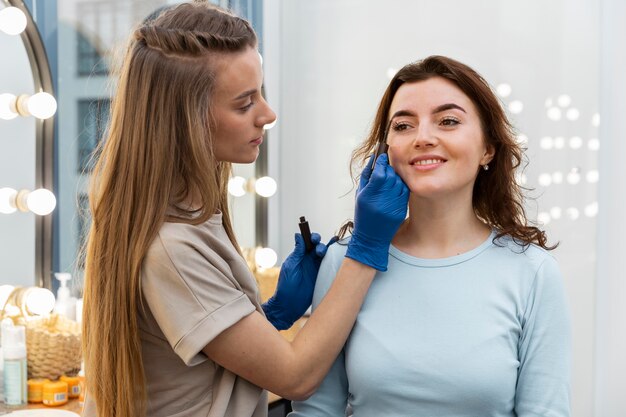Can Botox for Migraines Affect Your Facial Appearance?
Imagine a day free from the relentless grip of migraine pain. For many, this dream becomes a reality through a treatment that sounds both intriguing and mysterious: Botox. Known for smoothing wrinkles, Botox has also gained traction as an effective solution for chronic migraines. However, this raises an often-asked question: Does Botox for migraines change your face? Let’s delve into this fascinating topic and explore the multifaceted nature of Botox, how it works for migraines, and its potential effects on your appearance.
Understanding Botox: A Dual-Purpose Treatment
What is Botox?
Botox is derived from a neurotoxin produced by the bacterium Clostridium botulinum. While its origin might sound daunting, in clinical settings, Botox is purified and used in very small, controlled doses. This allows it to be harnessed safely for various medical and cosmetic treatments.
Botox for Migraines
When it comes to treating chronic migraines, Botox works by targeting the nerve endings and blocking the release of pain chemicals, ultimately reducing migraine symptoms. Administered through injections around the head and neck, this treatment can significantly decrease the frequency of chronic migraine attacks.
Does Botox for Migraines Alter Your Facial Appearance?
Cosmetic vs. Therapeutic Use
The primary difference lies in the purpose and location of the Botox injection. While cosmetic Botox is typically injected to relax facial muscles and reduce wrinkles, Botox for migraines targets specific regions like the forehead, neck, upper back, and sometimes the jaw and temples.
Potential Side Effects on Facial Appearance
Temporary Effects: Just like any medical procedure, patients might experience temporary effects such as mild swelling or bruising at the injection site. These effects are generally short-lived.
Facial Expressions: Some individuals may notice a slight reduction in facial expressiveness, particularly if injections relax muscles around the forehead. However, when administered correctly, Botox should not significantly alter facial animations.
Individual Variation: Each patient’s anatomy and muscle structure are unique. As such, reactions can differ from person to person.
Balancing Therapeutic and Cosmetic Needs
It's important to communicate your concerns and desired outcomes with the administering healthcare professional. This dialogue ensures that facial aesthetics are preserved while achieving optimal migraine relief.
The Benefits Beyond Aesthetics
Effective Migraine Relief
Botox has been proven to decrease the frequency and severity of migraines, offering significant relief to sufferers who have tried other treatments without success. For many, this improvement in quality of life far outweighs any minor, temporary changes in appearance.
Boosting Confidence and Well-being
Frequent migraine sufferers often miss work, social engagements, and family events, leading to emotional and psychological distress. By reducing migraine episodes, Botox treatment can improve overall confidence and equilibrium in daily life.
Navigating the Decision to Choose Botox for Migraines
Consultation with a Specialist
Before embarking on Botox treatment for migraines, it’s crucial to consult with a neurologist or a healthcare professional specializing in migraine management. They can provide personalized insights and set realistic expectations regarding the treatment's impact on both migraines and facial appearance.
Weighing Pros and Cons
Consider the following before making a decision:
- Effectiveness: How likely is Botox to reduce your migraine frequency?
- Frequency of Treatment: Botox injections for migraines typically need to be repeated every 12 weeks.
- Insurance Coverage: Determine whether the treatment is covered by medical insurance, as costs can vary.
Myths and Misconceptions About Botox for Migraines
- Botox is Only for Wrinkles: While cosmetic applications are well-known, Botox’s efficacy in treating medical conditions like migraines is backed by extensive research.
- Permanent Facial Changes: Any changes to facial appearance are generally temporary and resolve after the Botox effects wear off.
- Botox is Painful: The procedure involves minimal discomfort and is often described as feeling like a small pinch.
Enhancing Treatment Outcomes: Tips for Patients
Pre-Treatment Checklist
- Consult Thoroughly: Discuss all your concerns and medical history with your healthcare provider.
- Avoid Blood Thinners: Refrain from taking any blood-thinning medication or supplements before the procedure, as they might increase bruising. Always consult with your doctor before making any changes to medication.
Post-Treatment Care
- Follow Instructions: Your practitioner will provide guidelines to minimize any side effects and optimize results. Adherence to these is crucial.
- Monitor Symptoms: Maintain a migraine diary to track the frequency and intensity of attacks post-treatment.
A Journey Towards Relief
While Botox is primarily known as a wrinkle-smoothing elixir, its role in alleviating migraine pain is profound. For those battling chronic migraines, the potential facial changes—minimal and often temporary in nature—are often a small price to pay for the possibility of relief from debilitating pain. By focusing on both physical and mental well-being, Botox for migraines represents a promising option in the journey toward healing.
Key Takeaways on Botox for Migraines:
- Dual Purpose: Botox serves both cosmetic and therapeutic roles, with migraine treatment focusing on specific muscle areas.
- Temporary Impact: Any changes to facial appearance due to Botox for migraines are generally temporary and subtle.
- Consultation: Engage with a specialist to assess whether Botox is the right choice for your migraine treatment.
- Boosts Quality of Life: Decreasing migraine frequency can significantly enhance both physical and emotional well-being.
- Informed Decision-Making: Weighing benefits against potential drawbacks can help in making a confident choice.
🔍 Consideration: Always engage in a comprehensive discussion with your healthcare provider before starting Botox treatment for migraines to ensure it aligns with your health goals and aesthetic preferences.
